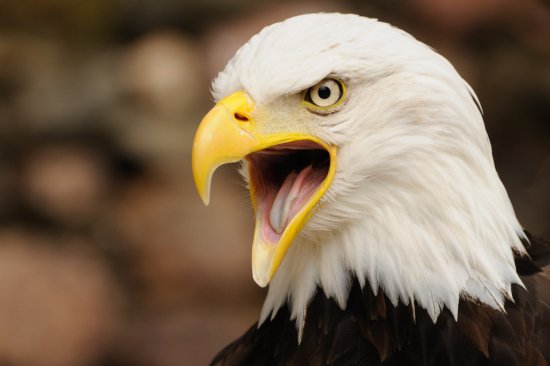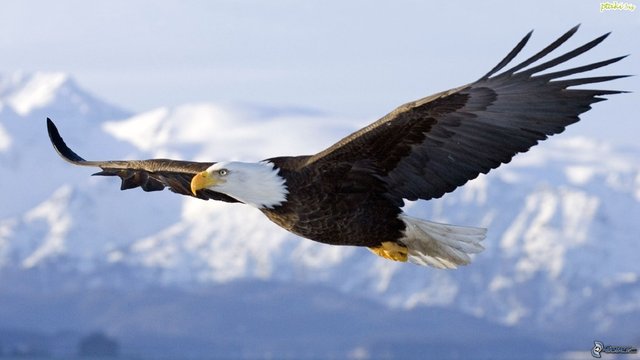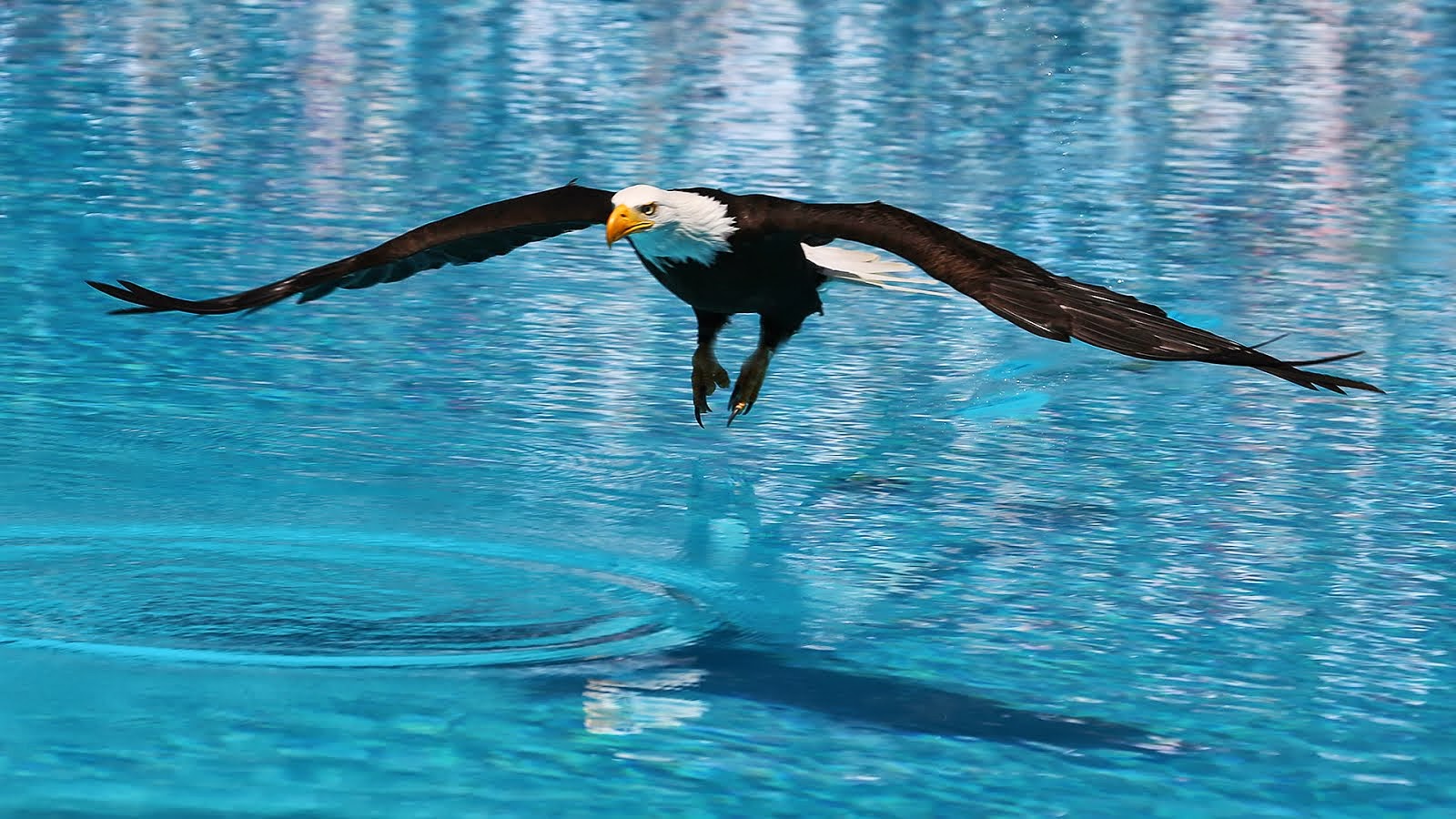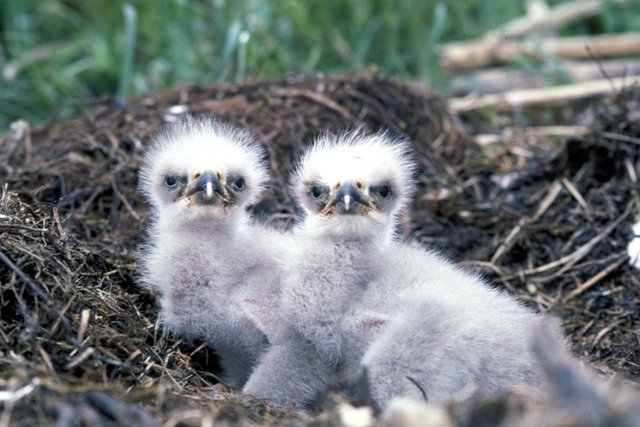Haliaeetus leucocephalus - Bald Eagle magnificent

Description identification
In adults who have reached the age of 5 to 6 years, there is no dimorphism and the sexes have a resolutely identical plumage. As the name suggests, the head is completely white. Nape, chin, upper covers, underwing and tail are also white, but with a slight shade of cream or pale buff. The rest of the plumage is predominantly dark brown, varying from black-brown on the upper parts and on the remiges to dark sepia on the lower parts. The top is usually darker, while the underside is more reddish or brownish in color. The feathers of the scapulars, sub-arteries, breast and abdomen are whitish or pale brown. The iris is pale yellow, the orbital bare skin, the wax, the beak and the tarsi show a yellow-cadmium color. The greenhouses are black.
First-year juveniles have an all-black top and a tawny or brownish underside. The tail is similar but displays a dirty white hue on some nets. The underside of the wings is whitish. The bill is greyish yellow. Legs and feet are pale yellow-lemon. In 2-year-old subadults, white feathers are reduced to mere flecks on the outer feather fillets and a narrow streak on the middle pair. The head is brownish, the cheeks and mumps contrast with the white area of the intrascapulars. The feathers of the body have a whitish base but have a variable hue on the lower parts. The beak is black, the legs greenish yellow. Subadults 2 to 4 years old are quite like their parents. However, the head and the rectrices retain dark streaks, vestiges of their former livery. The contribution of white on the underside is variable.

Habitat
Given its dietary requirements, the bald eagle occupies a fairly easily definable habitat: it is, for the most part, a place likely to provide fish of fairly good size, not too far from the site nesting and enjoying relative calm during breeding. Under these conditions, it is generally found near the coast, on the banks of rivers, the shores of lakes or the edge of the oceans. The bald eagle prefers bodies of water greater than 11 km in circumference and lakes larger than 10 square kilometers. This bird needs perching and nesting old trees or old mature coniferous patches. The selected trees must provide good visibility and form an open structure, but size is not as important a criterion as the proximity of water. The bald eagle is very sensitive to disturbance caused by human presence, so it remains far enough away from activity and settlement areas, on average between 1 and 2 kilometers away from any source of disturbance.
Behavior character traits
Bald eagles are clearly territorial, at least during the nesting season. In Florida, the raptor's area of influence typically extends 800 meters in all directions around the nest. Along the Alaskan coast, the nests are on average 1.7 kilometers apart, which is largely the highest concentration of sea eagles in North America. Outside the nesting period, population densities vary depending on the availability of food. In the fall and early winter, the largest gatherings of eagles occur in the Chilkat Valley where approximately 3,500 birds congregate to feed on salmon that come to spawn.
Bald eagles are partially migratory. If their territory is adjacent to bodies of water always alive, they occupy it all year long. On the other hand, if the waters are caught by the ice, making any fishing impossible, the eagles migrate to the south or the coast. When they move, the bald eagles give the impression of being powerful sailboats using the thermal and ascensional currents. They can reach speeds of 56 to 70 kilometers per hour when they hover or flap their wings. Their speed is reduced to 48 km / h when they carry a fish. They dive at over 120 km / h. Migration occurs in the daytime when the sun produces thermal currents.
Diet and diet
Although their menu is mainly made up of fish, bald eagles have a varied and opportunistic diet. In some areas, waterfowl such as coots, ducks, fulmars, puffins and alcids account for up to 50% of the prey. Mammals such as hares, Norway rats (Rattus norvegicus), and young sea otters are also sometimes a significant complement. However, fish, particularly catfish, carp, perch, salmon, and trout that flow upstream to spawn, form the predominant part of the diet, sometimes accounting for more than 90% of catches. Bald eagles have four main hunting techniques: the first two consist of dive into the air or a perch. They are not always successful, ensuring only 25% success. The most successful strategy is to wade through the shallow water and grab the fish with its beak. Finally, the least used technique is to wait patiently at the edge of the ice and catch prey when it comes. Bald eagles are powerful birds, capable of carrying heavy prey that they clutch through their awesome claws. Their fingers are equipped with spicules that allow them to more easily catch fish whose scales are known slippery. When they hunt, they easily dominate other predators such as coyotes, foxes, vultures or gulls and force them to leave. In competition with the Golden Eagle, none really takes the ascendancy and the outcome often depends on the size of the individual. Bald eagles tend to hunt collectively when they hunt mammals: a bird takes short flights over their territory to flush them out of their hiding places, another eagle catches them that the victim gushes into the open space.

Nesting reproduction
Bald eagles reach sexual maturity around the age of five. When they are able to reproduce, they usually join their place of birth. This phenomenon is known as philopatry. Bald eagles get together for life. However, if one of the members of the couple disappears, the survivor begins to find a new partner. Similarly, when a couple repeatedly fails to carry out a brood, the two partners decide by mutual agreement to break the marriage bond.

Before mating, bald eagles undertake elaborate displays during which they fly very high in the air with dive descents and acrobatics. The most spectacular part occurs when the two partners seize by the greenhouses and separate only when they reach a short distance from the ground.
These raptors have a gigantic nest that they reuse for several successive years. In each season, the couple adds additional pieces of wood, so that the nest and redeveloped can reach 4 meters deep, 2.50 meters in diameter and can weigh up to 3 tons. The nest is built mainly with branches, it is placed in a large tree near the water. Otherwise, it is placed on the ground. Spawning has 1 to 3 eggs, but it is extremely rare for 3 chicks to fledge. The parents turn in turns for 34 or 35 days. The one who does not brood is in charge of feeding the brood and renewing the nest lining. The stay of the young at the nest is particularly long. They only take flight between 70 and 92 days after hatching. Despite predation by magpies, crows' gulls, black bears, and raccoons, brood productivity seems quite high, sometimes averaging more than one chick per brood.
Distribution
The bald eagle is present on a large part of the North American continent. It breeds from central Alaska, Yukon, and the Northwest Territory to Newfoundland through Saskatchewan, Manitoba, Ontario, Labrador, and Quebec. The southern limit of its nesting area is in the Great Lakes and Maine. He is sedentary along the Pacific coast, from the Aleutians to the California Baja, as well as on the Atlantic shores of New Jersey to Florida. The most northerly birds migrate south of their range in the Rockies and Upper Mississippi. The species is usually divided into 2 races: H. l. leucocephalus, the type race (southern United States and Baja, its area overlapping with that of alascanus in the north and central United States). H. l. alascanus (Bering Strait south to Oregon, Idaho, Wyoming, Minnesota, Wisconsin, Michigan, Ohio, Pennsylvania and Maryland).
Congratulations @diamantika! You received a personal award!
Click here to view your Board
Do not miss the last post from @steemitboard:
Congratulations @diamantika! You received a personal award!
You can view your badges on your Steem Board and compare to others on the Steem Ranking
Vote for @Steemitboard as a witness to get one more award and increased upvotes!